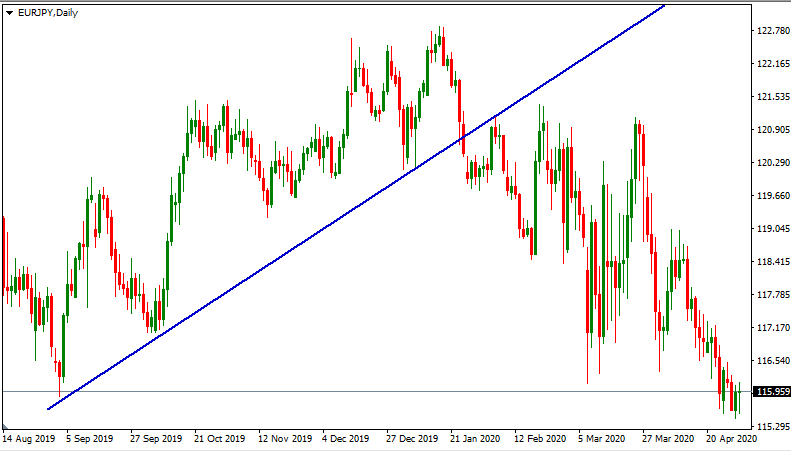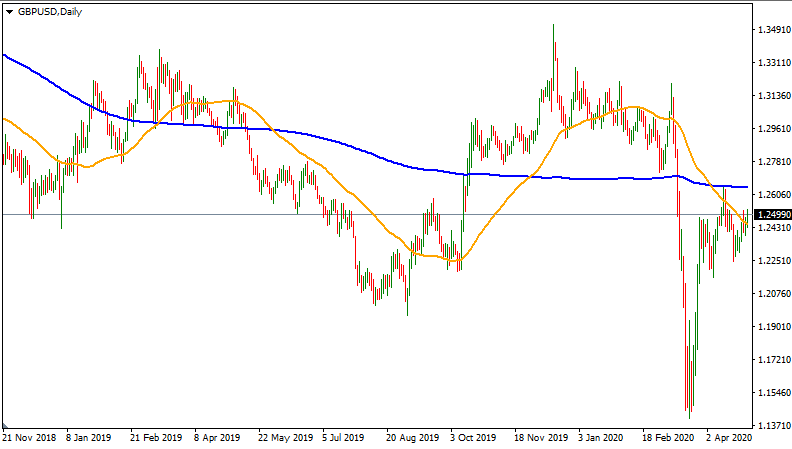As mentioned before there are many price action trading strategies in the FX, however in this article we will focus on the simple ones, this include:
There is no single best Forex price action strategy. Every approach might have its advantages and drawbacks. Therefore, in order to get a better understanding of how price action strategy works in Forex, we will go through each method in more detail.
A trendline is not horizontal, but a diagonal line. There are only two types of such trends. A falling line signifies that the currency pair is in a downtrend, however, if it manages to break above it, then this can be a major sign of reversal.
On the other hand, a rising line shows that the pair is in an upward trend. If at some point the price manages to break below it, then this might indicate that the trend has been reversed.
To get a better idea, how to draw the line and interpret those charts, let us move on to some real-life examples, by taking look at this daily EUR/JPY chart:

As we can see from the above, by summer 2019, the Euro was falling against the Japanese yen. The situation changes significantly from the beginning of September when EUR/JPY had a reversal and entered a clear uptrend. Throughout the next few months, the pair had at least three major pullbacks and the price got closer to the upward trend line. However, during each occasion, the Euro bounced back and reached new highs. From September 2019 to January 2020 the single currency had a strong showing, rising from 116 levels to well above the 122 mark.
Regardless of this development, what happened next might have been surprising for some traders. Before the end of January, the Euro started to fall dramatically, eventually decisively breaking below the upward trendline. The pair tried to rally and settle for ranged trading near the psychologically important 120 level, however, after a few weeks of fluctuation, even this support has given way and by the end of April, the pair was trading just above 115 mark.
So basically, this Forex price action strategy involves an analysis of several charts. Obviously, not every single currency pair is engaged in a trend. Some pairs are moving sideways and have settled for ranged trading. Therefore a trader does not have to force a trendline on a chart, where there is not a clear uptrend or a downtrend.
The next stage involves connecting points. In case of an uptrend, a trader has to find two bottoms and with downtrends, two peaks are needed.
After this, it is possible to come up with some conclusions. For example, if the price action is confined above the upward moving trendline, then a trader might conclude that this is a bullish sign for the currency pair. On the other hand, if the price breaks below this line, then it can point to reversal and can be considered as a very bearish sign.
The opposite is also true. Traders might consider opening the short positions for those pairs which are engaged in a downward trend. However, if the given currency manages to break above the downward trendline, then this can point to a major trend change and is generally considered to be an important bullish sign.
Trading support and resistance
As mentioned before, sometimes currency pairs settle for range trading and there are no visible signs of any trend. In this case, traders can look for two points. The support stands near the lowest point of the recent price action, where the price does not fall below this level. The resistance level is located at the high points where the given currency has not risen above that mark. After identifying those two points, traders can draw two flat lines to make support and resistance more visible on the chart.
For the purpose of a better illustration of how this Fx price action strategy works, let us take a look at this daily GBP/JPY chart:

As we can from the above, from late December 2019 to February 2020 the GBP/JPY pair has settled for a consolidation. It was confined within roughly 140.50 to 145 range. In fact, the price tried to break out of resistance for at least 4 times, but on each occasion, it fell all the way back to 141 mark. The pair also tried to break below the lower line for at least 3 times, however, in each case, the support level held out.
From late February, things began to change. The final attempt to break below 140.50 level succeeded and the Pound fell dramatically. Just in a matter of a couple of weeks, the British currency traded at 124 mark against the Japanese yen. During the following trading sessions, the GBP/JPY regained some of its losses and nowadays stands near the 133 level, still well below the previous range, mentioned above.
So as we can see from this example, price action trading strategies in Forex are not strictly confined to trend analysis, but traders can also identify the currency pairs who are consolidating and open positions, once they break above the resistance level or alternatively below the support line.
Using 50 and 200-day Simple Moving Averages
Another simple price action strategy to trade Forex would be the use of one or several moving averages. For example, a 50-day
simple moving average (SMA) is constructed by taking the closing price of a given currency pair for the last 50 business days. In general, when the price stays above the moving average, it is considered a bullish sign, however, if it falls below this line, then it is viewed as a bearish indicator.
One popular urban Forex price action strategy is to use 50-day SMA in conjunction with a 200-day simple moving average.
In order to see how this might look like, let us take a look at this daily GBP/USD chart:

As we can see from this chart, by the late Autumn, 2018, the Pound was in a bear market against the Dollar. However during the following months, the British currency managed to get above the 50-day SMA (represented by the orange line). This signaled a resurgence of GBP, which rallied for three months and eventually even overcame the 200-day Simple Moving Average indicator (represented by the blue line), rising from 1.24 to well above 1.33 level.
Despite those events, this uptrend was a short-lived phenomenon. By the end of April, the GBP/USD broke below 50-day SMA and shortly thereafter pierced the blue line as well. After several weeks the 50-day SMA has crossed the 200-day Simple Moving Average, which was another major bearish sign. Sure enough, by August 2019 the pair collapsed to the 1.20 mark.
The Pound had another round of resurgence from September 2019 to February 2020, however after the COVID-19 concerns have taken over the market and the Bank of England cut rates to record low of 0.1%, the British currency collapsed yet again, this time falling to a multi-decade low of 1.15 level.
Nowadays GBP/USD trades near 1.24 mark and tries to break above the 50-day simple moving average. If this happens and the Pound also pierces the blue line, then it might be a sign of major reversal. However, as long as the pair remains below those two indicators, it is still considered as a bear market and the British currency might resume its downtrend.
So as we can see, price action trading strategies for Forex do include the use of moving averages and quite often it might be a helpful tool to determine the trend direction and identify potential reversals.